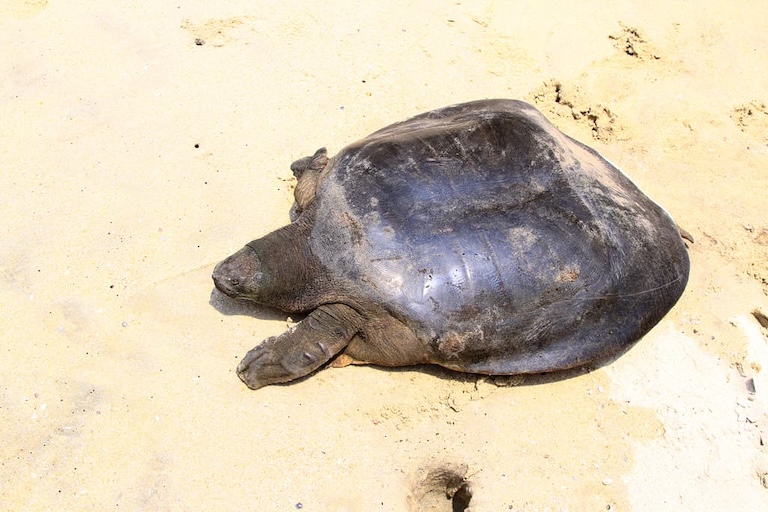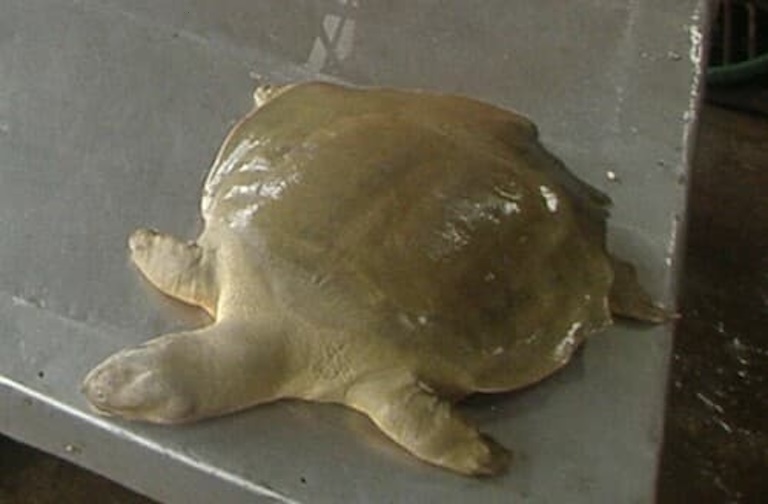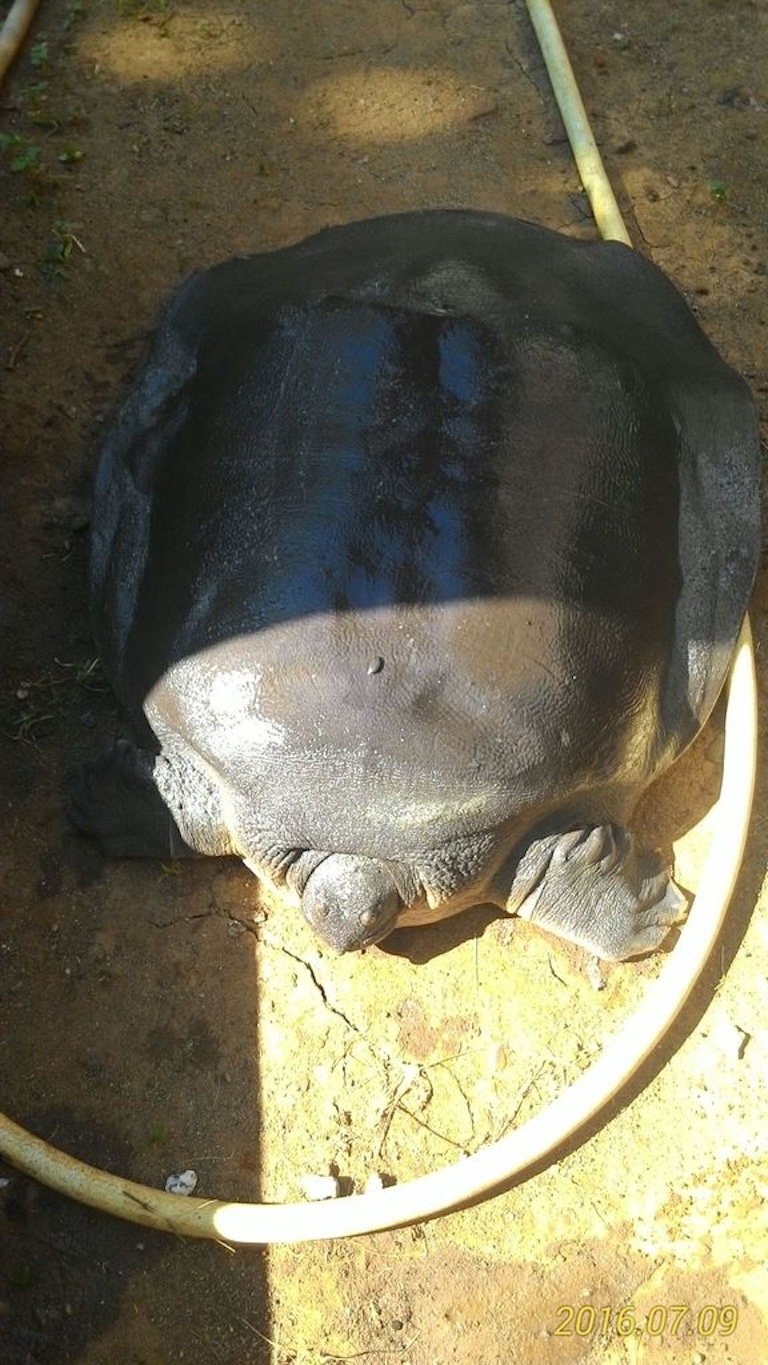Asian Giant Softshell Turtle Profile
The ‘80s and ‘90s were awash with TV jingles. Almost all cartoons and shows had intros sung by talented musicians, and a bunch of them were absolute bangers.
But the path to a masterpiece is littered with failed experiments. To see how far some of them came, consider this rejected pitch for a show about Japanese Testudines:
“Asian giant softshell turtles, Asian giant softshell turtles, Asian giant softshell turtles, lookin’ like a pancake. Turtle power!”
Rubbish. Luckily, they’re much better expressed in the animal blog format.

Asian Giant Softshell Turtle Facts Overview
| Habitat: | Forest, wetlands, coastal, slow-moving water |
| Location: | Mostly SE Asia, also Sri Lanka, Bangladesh, up to Hong Kong |
| Lifespan: | Unknown |
| Size: | Around 1 metre (39 in) long |
| Weight: | More than 100kg (220 lb) |
| Colour: | Olive green |
| Diet: | Mostly crustaceans, molluscs and fish, but sometimes plant material |
| Predators: | Philippine crocodile, humans |
| Top Speed: | Slow |
| No. of Species: | 1 |
| Conservation Status: | Critically Endangered (IUCN) |
The Asian giant softshell turtle is a very large animal, though its maximum size is dubiously reported due to its consistent misidentification. Yet, it is one of the largest freshwater turtles, and despite this, one of the least well-understood.
This is a serious problem for the species, as it’s being hunted to extinction and its habitats are decreasing too.
Interesting Asian Giant Softshell Turtle Facts
1. They’re Trionychids
Asian giant softshell turtles (or, from now on: AGSTs) are members of the Cryptodira order. This is the larger of the two orders of turtle – the other being the side-necked turtles, whose necks are so long they can’t retract their heads properly.
As Cryptodira, they’re related to tortoises and sea turtles and contribute to the family Trionychidae, which includes the rest of the softshell turtles. These are squishy-looking, leathery turtles whose bony shells have been replaced with toughened skin, making them look more like handbags than Mini Coopers.
This family is named after the three webbed, clawed toes found on each foot, and this is a family known for its lethargy. These are ambush predators, and they love to stay submerged for hours at a time.
Softshells are some of the largest freshwater turtles you’ll find, so you’d think we know a whole bunch about them, but we surely don’t.

2. They are often mistaken for other species
There are claims that this turtle can grow to almost 2m long, but the specific reports are hard to corroborate, and it’s likely that they were misidentifying the closely related Yangtze giant softshell turtle, which has an even worse intro song and is more widely recognised as the largest freshwater turtle.
This is true of the heaviest recorded specimen, too, weighing in at over 250 kg.
But AGSTs are by no means small animals and can grow to at least a metre long and weigh over 100 kg.
3. They’re weird-looking
As mentioned, these turtles differ from the turtles with hard, domed shells, in that – as their name suggests – their carapace is leathery, rather than bony. And in place of the nice, spacious dome of their hard-shelled cousins, these animals look a bit like someone took the poles out of their tent.
Their faces are quite porcine, with a pair of flattened, front-facing nostrils and two beady little eyes peering out. This leads to their other name, the frog-faced softshell turtle.
The distinctly flattened appearance does serve a few purposes. First, they cause less drag when moving through the water, and they’re said to be faster on land too, because of it, but moving isn’t something this species is really known for.
The other advantage is that they are easily buried in the sand or silt of the river bed, where they can remain for hours, poking their little snouts out to keep watch.
4. They breathe, sometimes.
This whole family is characterised by their ability to respire while submerged. Some species have been reported to excrete urea while underwater, and there’s a strange and amazing adaptation involving their pharyngeal skin, through which these turtles are able to absorb oxygen from the water.
In this context, the absorbent skin acts like gills, extracting oxygen from the water and releasing carbon dioxide back into it.
They get around 70% of their O2 needs this way, meaning they only need to come up and take a real breath twice a day.
This allows them to remain hidden beneath the surface, where they only move if and when food arrives, or when they’re plucked out by hungry humans. 1
5. They’re tasty
This species, along with many others in its family, is considered a delicacy in most of their range and is commonly eaten in Chinese stews.
Softshell turtles are apparently so tasty that they were farmed in Japan at an industrial scale by the 19th century. This is great news for some species, as their numbers skyrocketed, but for the AGST, there was no such luck. 2
6. They’re in serious trouble
The destruction of the wild habitat for this species is significant, and it’s now listed as critically endangered and still in decline. Water levels dropping, human settlement increasing and increased tourism all threaten the nest sites of this species, as well as continued hunting for food, and their numbers aren’t supplemented by any kind of industrial farming, in the way that the Chinese species are.
Small numbers exist in captivity, but overall this is a species that’s really struggling and needs urgent attention.
Thankfully, some organisations are making efforts in that regard. 3

7. More help is needed
This is one of the largest and least understood freshwater turtles in the world, and its cryptic nature makes it hard to find, let alone observe.
Thankfully, a surprise population was found in Cambodia’s Mekong, but that was in 2007, and since then, there hasn’t been a whole lot of attention towards this strange-looking animal.
A breeding pair, taken from the wild, shows a reproductive success of around 46%, but this came after seven years of inaction, so the data is sorely lacking on their reproductive habits and requirements.
But protecting nest sites is the most straightforward way to help the species, and in Cambodia, the Turtle Survival Alliance partnered with the Wildlife Conservation Society and the Royal Government of Cambodia’s Fisheries Administration to do just that.
This project is said to have located 188 nests and released almost 3000 hatchlings in the last year. This is a great start, but it still needs widespread exposure and collaboration to continue across the enormous range of this species. 4
Asian Giant Softshell Turtle Fact-File Summary
Scientific Classification
| Kingdom: | Animalia |
| Phylum: | Chordata |
| Class: | Testudines |
| Order: | Cryptodira |
| Family: | Trionychidae |
| Genus: | Pelochelys |
| Species: | cantorii |
Fact Sources & References
- Bob Thomas (1984), “Pharyngeal Breathing in Softshell Turtles”, Loyola University New Orleans.
- Shi Haitao (2008), “Evidence for the massive scale of turtle farming in China”, Cambridge University Press.
- “Asian Giant Softshell Turtle”, IUCN Red List.
- World Wildlife Fund (2007), “Rare Soft-Shell Turtle, Nesting Ground Found In Cambodia”, Science Daily.
